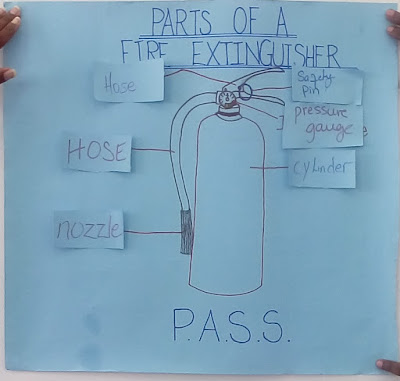Fire Extinguisher Graphic Organizer
Industrial Arts Lesson: Fire Safety
- Students wrote what part of the fire extinguisher the line is pointing to on the taped rectangular papers. Their answers were: "nozzle," "cylinder," "safety pin," "pressure gauge,"hose," and "hose" again. It is obvious that one of those responses was wrong because there is only one hose.

But this was not a moment to name and shame, but to eliminate the misunderstanding and help that student who got the part wrong that he or she made a great effort. Point out the error nicely and thank all of them for their efforts.
When all the responses were given, they removed the rectangular papers to see if their answers were correct. The answers were revealed under the rectangular papers.If they match what the students wrote, then the student was correct.
Remember the extrinsic reward of praise. Praise the students who got it right and even those who got it wrong. Encourage them.
- The Industrial Arts group used a fire extinguisher graphic organizer, an important device in the lesson.
- The graphic organizer was used not only to teach the lesson, but also to assess the students' understanding.
- It captured and maintained their interest during the lesson. See other benefits of organizational strategies in the adjacent diagram.

Acronym was another strategy they used. An acronym is a mnemonic instructional strategy designed to help students improve their memory of important information.
- P. A. S. S. is the acronym used to help students easily remember the procedure for using the fire extinguisher:
- Pull the extinguisher,
- Aim the hose nozzle low toward the base of the fire,
- Squeeze the handle to release the extinguishing agent, and
- Sweep the nozzle from side to side at the base of the flames until extinguished.
Graphic Organizer: Video Clip
Other Parts of the Lesson

Setting a Purpose
This is a pic of the teachers writing and talking about the objectives (purpose) at the beginning of the lesson. This is a good strategy. Tompkins (2002) said purpose provides motivation and direction. Good readers tend to have a purpose when reading; so too should good teachers.
Remember to talk about these activities in your journals!
You can use pictures or diagrams in your journals.
The journal is now worth 30%.
Reflect on everything teachers!




No comments:
Post a Comment